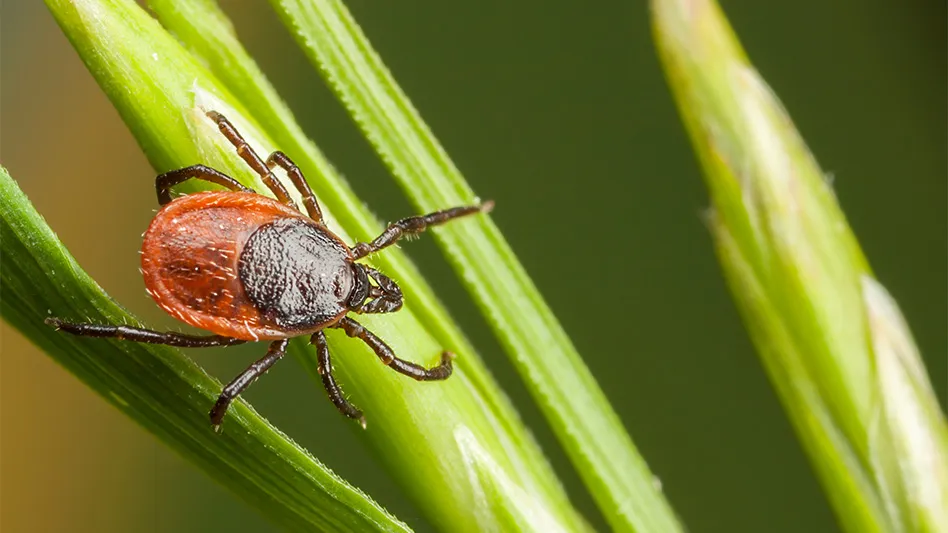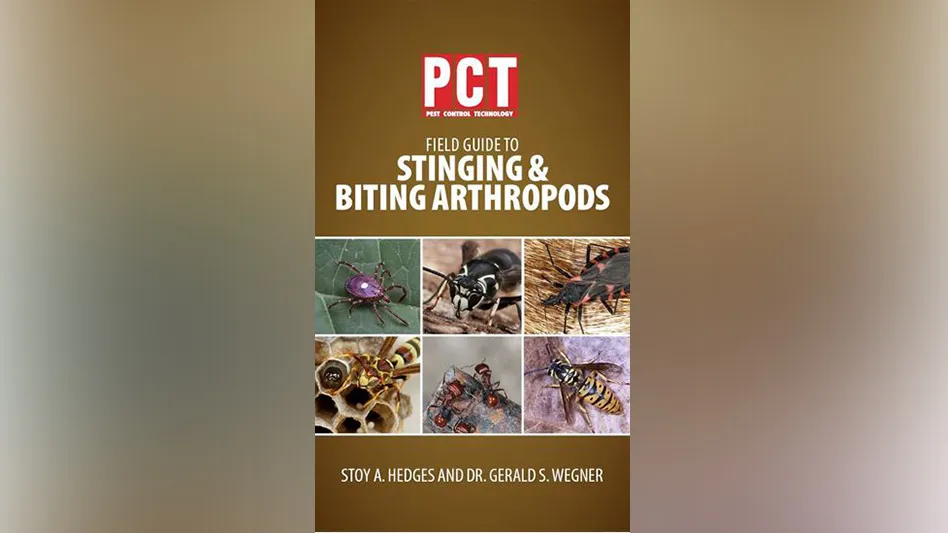Professionals agree: Nothing beats foam when it comes to treating voids. Whether in walls, metal tubing, under slabs or even drains, foam’s three-dimensional, shaving cream-like consistency fills hard-to-reach spaces, leaving residual deposits as it slowly breaks down. How are firms using these unique properties to control pests? Leading technical directors weigh in on best practices.
LOOKING BACK. Although “soapy solutions” for pest control have existed for decades, foam gained prominence in the late 1980s as a delivery system for termiticides. Faced with challenging environments like Florida’s high water tables and caliche soils in Texas and Oklahoma, professionals found foam’s slow breakdown helped “control where termiticide ended up,” said Eric Smith, technical services director of Lynchburg, Va.-based Dodson Bros., who worked extensively with early foam technology and equipment. Foam allowed technicians “to get into areas you normally couldn’t get into, such as under porches and in wall voids,” added Jerry Hatch, technical and training director, Eradico Services, Novi, Mich.
While the advent of non-repellent termite control products displaced the need for large-scale foaming for the most part, foam’s advantages still held allure, said Smith. The need for foams that could quickly fill voids and control a broad spectrum of pests led to formulation and equipment improvements throughout the 1990s.
EXPANDED FOAM CHOICES. Today, pest management professionals can foam many different kinds of material, including insect growth regulators, insecticides, bioremediation or microbial products and borates, said Mark Sheperdigian, vice president of technical services, Rose Pest Solutions, Troy, Mich. Three foam systems are available: ready-to-use, pre-measured and add-in agents.
Ready-to-use “foam in a can” is “very clean, very quick, very effective” for small void treatments, said Sheperdigian. “There are some fabulous products out there. But, if you’re going to foam for any length of time or for any great extent, it really is too expensive.” Ready-to-use products, however, require no mixing and no cleaning or maintenance of special equipment. They are a good approach for mixed routes where occasional spot treatments are required, said Smith.
Pre-measured products include some microbial materials packaged with foaming agent, Sheperdigian added. “All you need to do is add water and begin foaming.”
Foaming agents also may be combined with active ingredients, and then applied with a portable foamer. But, pay careful attention to the active ingredient’s label and state regulations to ensure foaming is not prohibited, Sheperdigian noted.
Although each system has advantages and disadvantages, foam is recognized for its “stick-to-it-ness,” which makes it particularly useful for void and vertical surface applications. Compared to liquids, which will seek the lowest level, “when you use a foam application, you have a better chance of keeping the (active ingredient) where you want it applied,” said Bayer Environmental Science Product Development Manager Dr. Byron Reid. Because its water volume is dispersed with a lot of air bubbles, the foam will stay in place long enough to be absorbed by surfaces inside the void, such as the two-by-fours or paper backing on sheetrock, he explained. “That helps you regulate off-target movement of your applications.” Less water also means less wetting and staining.
BEST-SUITED SOLUTIONS. Pest professionals find foam insecticides useful for controlling termites, ants, stinging insects and any pest existing in unreachable voids. “There’s nothing that will treat a dirt-filled porch like a foam,” said Smith. In walls, foam will flow around a pipe or gallery, allowing the active ingredient to reach target insects, said Whitmire Micro-Gen Product Development Manager Dr. Jim Cink. Louisiana adopted foam to control Formosan termites in living trees in the late 1990s, he said. Foam completely fills large tree hollows and engulfs the termite galleries. Liquid provides incomplete coverage, allowing termites to relocate to untreated parts of the tree.
Foams are well-suited for voids in outside walls of homes with polystyrene insulation, said Eradico’s Hatch. Dust adheres too heavily to the polystyrene, and liquid with petroleum distillate eats the polystyrene, “so foam will fill the void perfectly.” When used to treat interiors of metal and brass bed frames and under vinyl cove base, foam is an effective tool to control bed bugs, he added.
Foam increases technicians’ accuracy, said Hatch, citing barrier treatment along basement window thresholds and casements as an example. Gravity pulls liquid toward the bottom of windows, but “with foam, you can get the material in and allow it to move a little without having it get all over the place.”
Foaming microbes into commercial floor and sink drains to control flies is the mainstay of many fly management programs. Foam has “grip” as it slowly goes down the drain, allowing the bacteria to adhere to and begin eating the “gelatinous material” within, said Sheperdigian. Foams increase contact time, so the bacteria have time to start working and build up on a biofilm, added Jeff Weier, director of technical services, Sprague Pest Solutions, Tacoma, Wash.
Organic decay is a breeding ground for small flies including the vinegar fly, phorid fly, drain fly and fungus gnat, among others. The idea is to find the flies’ breeding source and eliminate it, said Dodson Bros.’ Smith. Weier uses looser foam on worn floor tiles. The material wicks through worn grout to where water and organic matter gather — “hidden areas where flies may be breeding.” Smith also applies foam to gunky soda lines. “Foam won’t drip off like liquid. It soaks in gradually and gets the job done,” Smith said.
Foaming with bioremediation products is based on sound ecological principles, said Weier. Eliminating pests’ food source provides a more permanent solution to pest problems. “It really fits into an IPM program or green program very well,” he said.
So, what about cost? Foaming is “relatively inexpensive and it can be very inexpensive,” said Sheperdigian. “If you can solve a problem, it’s always less expensive” reminded Weier. “If you can eliminate fly breeding sources, or even cockroach breeding sources, you can go a long way to solving problems and reducing callbacks, and that saves you way more money than anything you spend on a foam.”
“Foaming is simple, but it’s not easy,” added Sheperdigian. “Knowing where to foam…is the expensive part of the job.”
ENHANCING FOAM PERFORMANCE. Not surprisingly, training is paramount to achieving good results with foam. First, get technicians used to foaming, said Sheperdigian. “Let them see what it will stick to.”
Next, focus on the equipment, which has come a long way from the termite rigs of the late 1980s when determining the air-liquid mix was “an art as well as science,” recalled Hatch. These early machines also put out considerable amounts of liquid. “We cannot wait for the foam to reform,” Sheperdigian said. “We need instant foam at the tip.
“New-generation foamers are battery-powered, plug-in or pressurized by hand. Portable, 2-gallon, hand-pump tanks have high volume. You can work for a long time before you have to reload.” Fewer pieces mean less maintenance, he added.
One-quart foamers are handy for pest management professionals who don’t need much foam, he explained, but they cannot be turned upside down without sucking air. Some models can be fitted with a section of Tygon tubing to overcome this. At about $20 each, quart units are an alternative to foam in aerosol cans, Sheperdigian said.
The best foamers allow technicians to adjust the air-liquid ratio to create stiffer or looser foams, Weier said. It’s easy to under-apply an insecticide as foam, since “most of what you are applying is air,” said Sheperdigian, adding that wet foam has less air than dry foam and is less susceptible to under-dosing. “If the label doesn’t explain how to achieve proper dose rates with foam, you may need to contact the manufacturer for more specific instructions.” Ready-to-use foams dispensed from a can are pre-mixed and properly dosed, eliminating the possibility of applicator mixing errors.
Other than gloves and goggles, foam requires no special safety equipment other than active ingredient label requirements.
According to Hatch, foam fits Eradico’s corporate philosophy of environmentally sound pest management. “Foam offers directed application and won’t affect anything outside of where we want it to be.”
The delivery system opens “windows of opportunity,” said Smith. In fact, foam applications are expanding beyond pest control to landscaping and agricultural markets, since it helps materials cling to plant leaves and reduce drift, said Bayer’s Reid. The future of foam will be a balancing act between ready-to-use products and innovative application equipment, he said. “There’s lots more to be done with [foam] in my opinion.”
Sheperdigian agreed. “I think it’s one of the up-and-coming application methods we have.”
The author is a frequent contributor to PCT.
Whitmire Micro-Gen to Unveil Microencapsulated, Non-Repellent Foam
Professionals seeking fast-acting, quick-to-apply foam for termites and general insect pests now have a new product option. Whitmire Micro-Gen will unveil the only microencapsulated, non-repellent foam — FastOut CS Foam — nationwide this year.
The ready-to-use foam meets professionals’ need for speed of control, both in knockdown and application time, said Whitmire Micro-Gen Marketing Manager Jeff Vannoy. “Taking 30 minutes to apply foam is not acceptable.” FastOut delivers an expansive, dry foam quickly and “is highly efficacious against a broad spectrum of (pest) species in a timely manner.”
The foam carries a food-handling label and is well-suited for controlling roaches in commercial kitchens. It quickly fills voids such as metal legs on freestanding kitchen equipment, which often harbor the pests, explained Dr. Jim Cink, Whitmire Micro-Gen Product Development Manager.
FastOut CS Foam won’t stain or damage surfaces, and is a good choice for sensitive accounts, added Cink. Compared to liquids that can run off, the foam will stay where applied, he explained. FastOut CS “will help mitigate any off target movement” of pesticide. In addition, it requires no mixing, or cleaning and maintenance of special equipment.
Microencapsulation enhances the foam’s coverage, extends its residual properties, and lowers the risk of mammalian toxicity, Vannoy added. Microcapsules attach themselves to pests, and can be transferred to other insects.
The new product underwent extensive studies at several universities, said Cink. “The results exceeded our expectations in every test.” Fast- Out CS Foam will be available via distributors this month.
Foaming Products
Editor’s note: What follows are some of the foaming products available to the pest management industry. Manufacturers, if you have a foam-related product you’d like featured, please send a press release and high-resolution photo to jdorsch@giemedia.com.
B&G Versafomer HH
www.bgequip.com
The stainless steel and brass B&G Versafoamer HH foamer is sturdy and easy to use, according to manufacturer B&G Equipment Co. Pest management professionals add foaming agent to the insecticide dilution and use the hand pump to pressurize the tank to apply thick foam. There are no knobs or adjustments to make — thick, wet foam is delivered every time. The XR valve ensures a consistent delivery rate with any insecticide, the company said. The tip on the valve is curved for delivering insecticide foam to wall voids or a biological cleaner to floor drains. This is a professional-grade foamer, and was built for every-day use in commercial and residential accounts.
Foam produced by the Versafoamer HH clings to the surfaces of wall voids and moves over and around obstacles beneath concrete slabs, the company said. The liquid insecticide in the bubbles quickly drains to the substrate to create a long-lasting residue.
Systems Environmental Products
www.pestspray.ca
Systems Environmental Products offers a commercial-grade foamer. The PC7495 Wet-Dry Foamer is constructed entirely of stainless steel and aluminum components, and is available with a 3- or 5-gallon pressurized canister. The company reports it is the only foamer made with the American-made Gast air compressor with a three-year warranty on the motor. The foamer comes with soft runner non-scuff wheels, a 25-foot, 115-volt power cord, a 35-foot twin line treating hose, as well as a twin line foam gun with an assortment of treating tools.
Bayer Environmental Science
www.bayerprocentral.com
With Premise Foam in a can for termite treatments, pest management professionals can provide homeowners with instant control. Premise Foam is pre-mixed for perfect consistency, which eliminates set up time, mixing concerns and bulky equipment for pest management professionals, the company reports.
Ideal for targeted applications, Premise Foam expands at a rate of 30:1, which delivers a lethal dose of imidacloprid to hard-to-reach areas, such as wall voids, termite galleries and floor joists. Premise Foam provides the same long-lasting residual of traditional Premise Liquid, and is ideal for subterranean and drywood termites, as well as ants, according to Bayer ES.
NPD
www.npdproducts.com/pct
NPD’s complete line of foam application equipment, accessories and ProFoam Platinum foaming agent all have been designed to work together to deliver consistent performance and foam expansion rates to meet all application needs, the company said.
The versatile JACK I (128 ounce) and JACK II (230 ounce) foam and liquid applicators can be used with hand pumps or air compressors, and have heavy-duty threaded brass fittings for durability and quick disconnects, the company said. The applicators come with two palm guns, a telescoping extension wand and seven applicator tips.
NPD’s ProFoam Platinum foaming agent has been independently tested and proven to be non-repellent, the company said.
ProFoam Platinum provides consistent expansion ratios when mixed with other products, the company said, and is available in quart- and gallon-size packages to meet the varied needs of pest and termite control.
Rockwell Labs Ltd
www.rockwelllabs.com
The Foamer Simpson is a 2-gallon foamer that produces a shaving cream-thick foam the same quality as a power foamer, the company said. It has a durable plastic construction, which makes it lightweight. It comes with an 18-inch extension wand that makes it easier to foam deep drains and other hard-to-reach areas, the company said.
In addition, InVade Bio Foam Hot Spot is a 16-ounce aerosol can containing the same blend of soil-derived microbes, natural citrus oil and foaming agent as InVade Bio Foam. The 360-degree valve allows dispensing the foam in any orientation, to easily hit hard-to-reach areas, the company said. It’s ideal for quick jobs without having to use your foamer, and is great as an add-on sale item, the company said.

Explore the January 2008 Issue
Check out more from this issue and find you next story to read.
Latest from Pest Control Technology
- Viking Pest Control Organizes a Charity Bike Build for Local Families
- Gaining Control of Structure-Infesting Carpenter Ants
- Big Blue Bug’s Brian Goldman Receives Rhode Island Small Business Person of the Year Award
- UF Researchers Examine How Much Bait it Takes to Eliminate a Subterranean Termite Colony
- Women in Pest Control Group Continues to Grow, Provide Opportunities in the Industry
- NPMA Announces Results of 2024-2025 Board of Directors Election
- Massey Services Acquires Orange Environmental Services
- Hawx Pest Control Wins Bronze Stevie Award for Sustainability





